Text
anyone remember scott sterling
#crunchyposts#i LOVED studio c back in the day i was there before scott sterling had 15 million views#i think also before they were at 1 million subscribers#i have been. terminally online for too long maybe lol#yt
0 notes
Text
DREAM GIRL
June 23, 1947
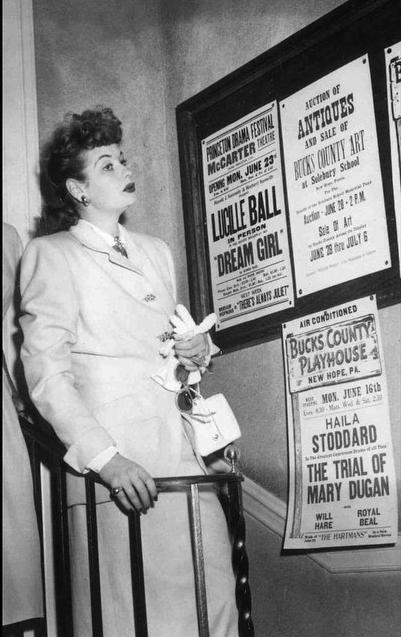
On this date in 1947, Lucille Ball opened in DREAM GIRL, produced at McCarter Theatre, Princeton, New Jersey for the Princeton Festival. The comedy had originally opened on Broadway on December 14, 1945, starring Betty Field and written and directed by Elmer Rice (then married to Ms. Field).
In 1937, Lucille Ball had performed on the McCarter Stage in the play HEY DIDDLE DIDDLE opposite Conway Tearle. The play launched a short tour headed to Broadway, but Tearle’s illness forced it to close in Washington DC, postponing Lucille’s Broadway debut. That would have to wait until 1960′s Wildcat.

Lucille Ball was the Queen of Comedy long before television. In this DREAM GIRL program bio, she continues the fib that she was born in Butte, Montana, finding it more exotic than Jamestown, NY.
Ball played the role of Georgina Allerton, a daydreaming bookshop owner. Subsequently, she toured the show, playing Boston, Detroit, Toronto, San Francisco, Oakland, Brooklyn, and the Bronx.
SYNOPSIS ~ Twenty-two year-old debutante Georgina is the owner of a small unsuccessful bookstore. She also writes novels. She has an overactive imagination and regularly escapes reality by means of her romantic daydreams about three men in her life, which are acted out on stage. The play's time span covers a single day of Georgina's life, during which several successive extravagant and often comic daydreams are portrayed.
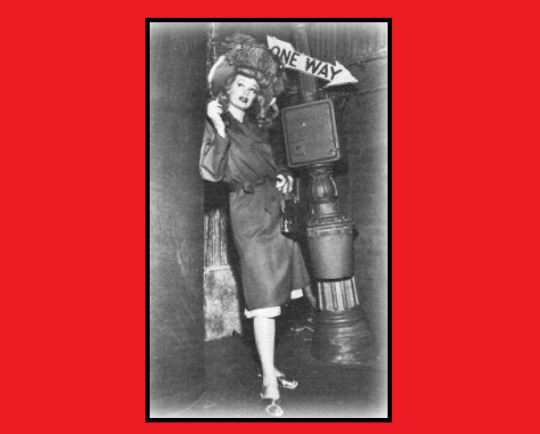
The play’s fantasy sequences seemed tailor-made for Ball’s style and comic wit. In a way, Georgina was a prelude to the “Lucy” character on TV, who is dreaming her way out of her suburban life - and sometimes succeeding. In the play, Georgina’s imagination takes her to:
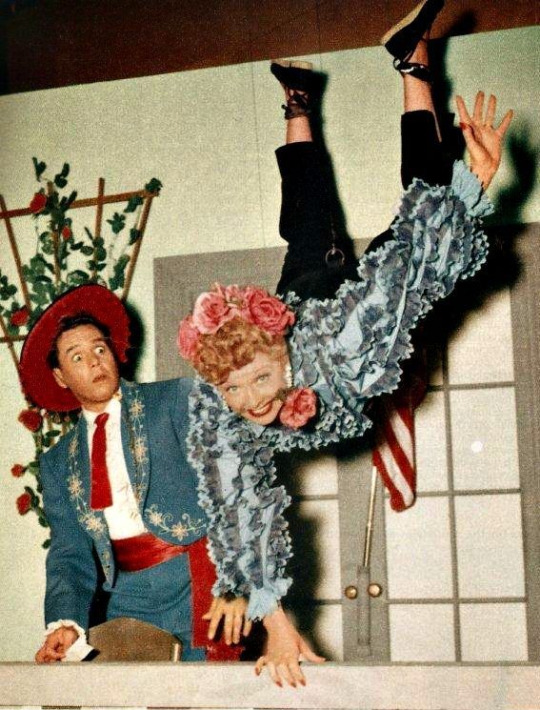
A balcony in Mexico...

The maternity ward of a hospital...
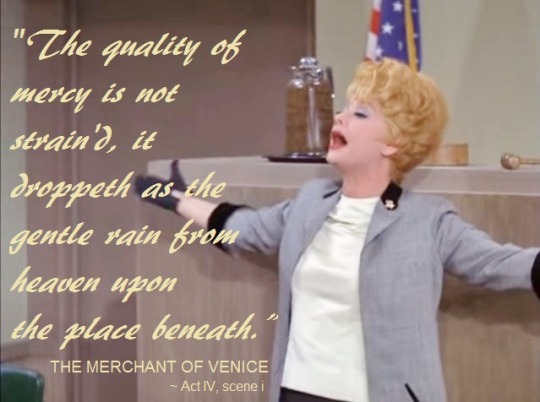
A stage where she plays Shakespeare’s Portia

A street where she is a ‘woman of the night’ in a scarlet red dress.


On two notable occasions, Lucy Ricardo’s fantasy or dream life manifested itself on our TV screens. In “Ricky’s Old Girlfriend” (ILL S3;E12) Lucy dreams of what her life would be like if Ricky left her to go on tour with his former partner, sexy Carlotta Romero.
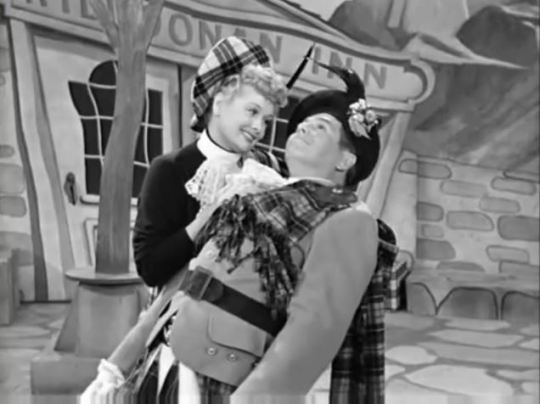
In “Lucy Goes To Scotland” (ILL S5;E17) Lucy dreams of visiting her ancestral home in Scotland while visiting London. Having just come from seeing a West End Musical, she dreams in the musical comedy format!
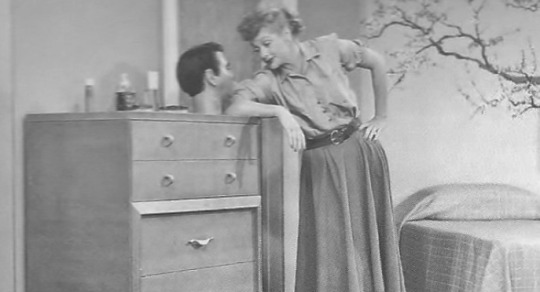
In “Lucy and the Dummy” (ILL S5;E3), after MGM offers Lucy a contract, she imagines fame and fortune but is fully awake. Lucille Ball pantomimes the joys and sorrows of stardom while a Theremin gives the sequence a dream-like, surreal quality. Lucy Ricardo is most like DREAM GIRL’s Georgina in this short reverie.

In “Lucy and the Monsters” (TLS S3;E18), Lucy Carmichael has a nightmare after watching a scary horror movie. The dream takes her and Viv to a haunted house where they encounter a variety of typical movie monsters and then turn into witches themselves - all before waking up.
DREAM GIRL CAST & CREW
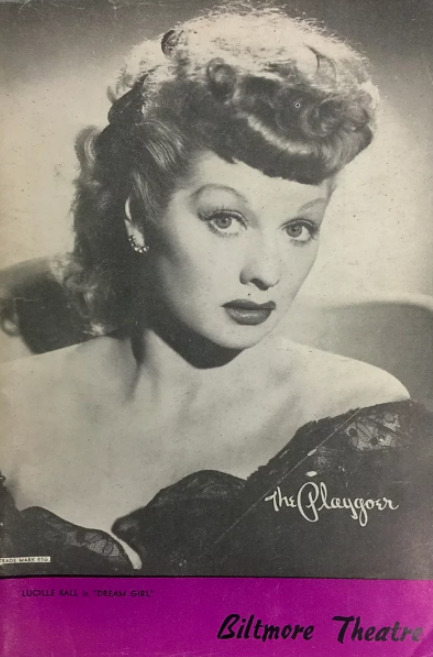
Herbert Kenwith (Producer) later directed 14 episodes of “Here’s Lucy” between 1969 and 1970. Dede Ball warned Kenwith that her daughter was indeed the bitch everyone said she was. Lucille snapped back: “I am not! Only when I’m working.”
Jack Benny (to Herbert Kenwith, about Lucy): "Herbert, you ought to call a psychiatrist for her."
Jus Addiss (Director) was the life partner of DREAM GIRL actor Hayden Rorke. Barbara Eden (who, like Rorke, also guest-starred on “I Love Lucy”) later remembered that Addiss and Rorke were “unabashedly gay” and often invited the “I Dream of Jeannie” cast over for parties.
Jo Mielziner (Settings) had also done the scenery for the Broadway premiere of DREAM GIRL in 1945. From 1949 to 1970 Mielziner won 9 Tony Awards. His designs were adapted by Richard Burns for the tour starring Ball.

The play co-starred Scott McKay as the imaginative writer. McKay played the role of Wilbur in the 1958 pilot for TV’s “Mr. Ed” but was replaced on the series by Alan Young.

Hayden Rorke, best known as Dr. Bellows in “I Dream of Jeannie”, was also in the cast. Lucy later employed him to play the Ricardo’s new neighbor, whom she suspects to be a spy, on “I Love Lucy.” He later returned to play a judge on a 1971 episode of “Here’s Lucy.”

Barbara Morrison was an English-born actress who came to Hollywood in the late 1940s. She did two episodes of “The Lucy Show” and three episodes of “Here’s Lucy.”
Lela Bliss went on to play Mrs. Shellhammer in the 1947 film Miracle on 34th Street, which also starred William Frawley.
Andrew Duggan later did an episode of Desilu’s TV series “The Greatest Show on Earth” (1964). He is best remembered as the voice of the Father in Disney’s theme park attraction The Carousel of Progress.
Phil Arthur appeared on Broadway from 1948 to 1952, his last play with Henry Fonda (Lucy’s one-time boyfriend) and Frances Baviar (Aunt Bee on “The Andy Griffith Show”). He began on television in 1949 and his last job on the small screen was as a background player on “Perry Mason” from 1961 to 1966.
Dorothy Elder began doing television in 1950, but her career only lasted until 1955, as a regular on “True Romances”.

Alan Hewitt was a veteran of sixteen Broadway shows, including the original production of Death of a Salesman (1949) and Call Me Madam starring Ethel Merman (1950). From 1964 to 1966 he played Detective Brennan on “My Favorite Martian.” In 1964, he appeared on an episode of “The Lucy Show.”
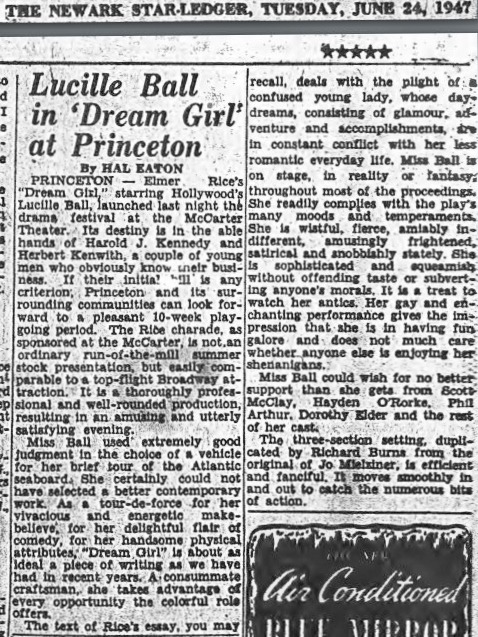
The Newark Star-Ledger review of DREAM GIRL, June 24, 1947. [Thanks to Eric C. Schwarz, research librarian extraordinaire, for the review.]
POST PRINCETON!
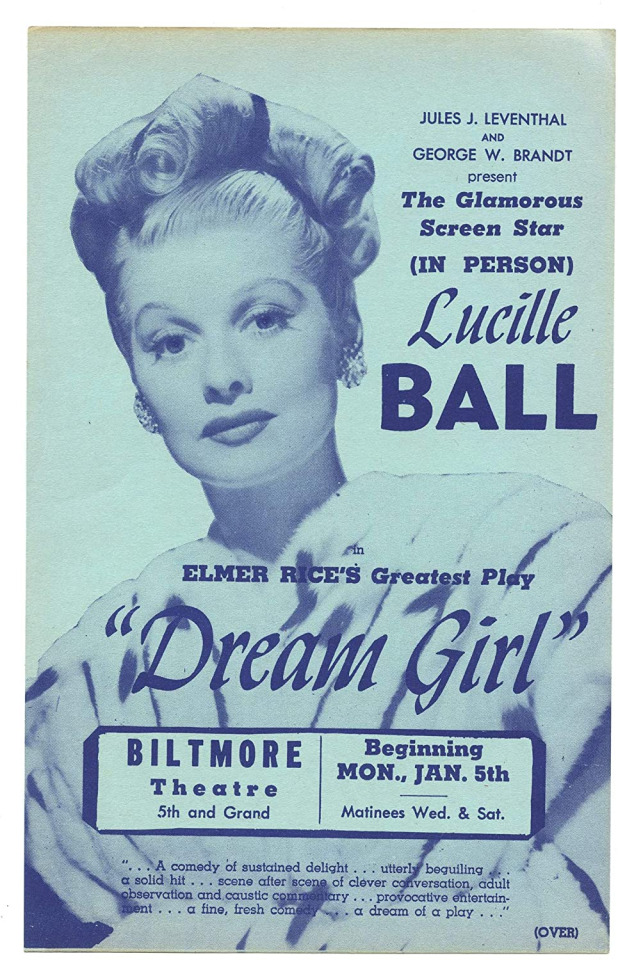
In January 1948, Lucille got the opportunity to recreate the role in Los Angeles, but fell ill with a virus shortly after it opened and the show closed prematurely. Because Ball was known for her film roles, promotion often said that she was appearing “Live In Person” - which seems obvious in a live theatre production!


Handbill for the Los Angeles production that was cut short by Ball’s illness. Lela Bliss took over for Barbara Morrison.



Souvenir program from the Brooklyn engagement at Brandt’s Flatbush Theatre in July 1947. It includes an excerpt from a write-up by Hall Barnell for Actors Cues about the rehearsal he attended at Malin Studios and a sketch of Ball from that day.

Detroit Music Hall - signed program.

Boston Production at the historic Shubert Theatre - signed program.
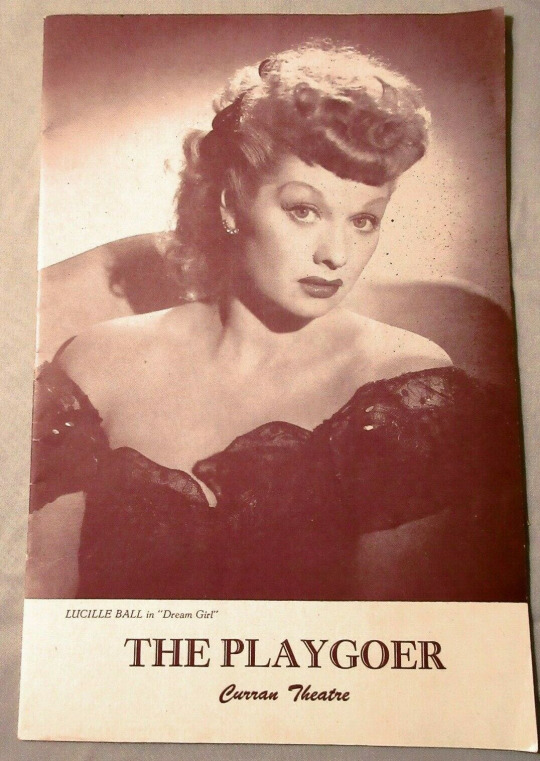
San Francisco production at the Curran Theatre.
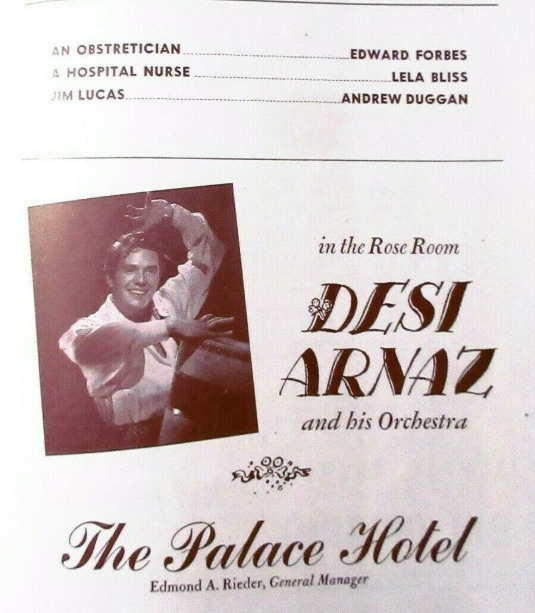
During this San Francisco engagement, Ball’s husband was not far away! Five blocks, to be exact. It is likely that Lucy and Desi stayed at the Palace Hotel while she was performing at the Curran. It is also likely that Desi’s performances were in lieu of a hotel bill for the couple!
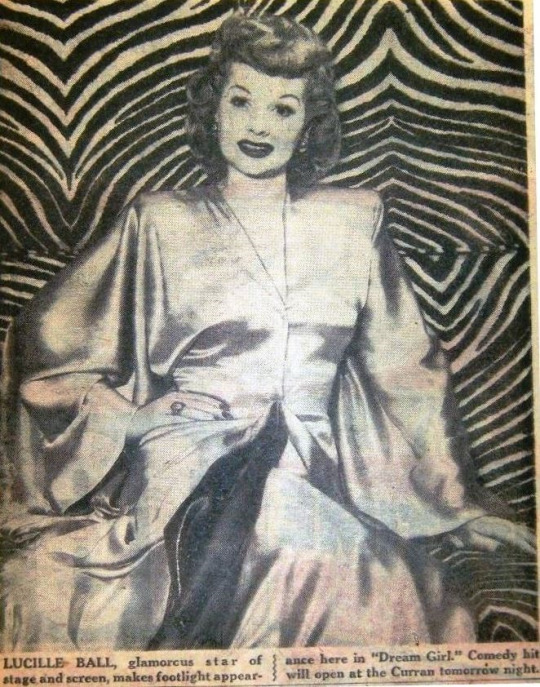
"I have seen other productions of this play, but the only actress whose performance really delighted me was Lucille Ball. She lacked… tender wistfulness, but her vivid personality and expert timing kept the play bright and alive." ~ Edgar Rice, Playwright
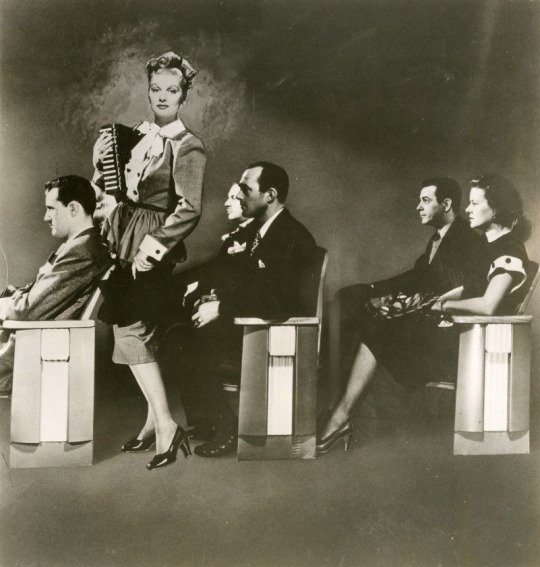
It is pretty clear that this photo was an early version of photo shop. Although it was created during the time of the play, it is quite obviously a manipulated photo.

In August 1947, the show had finally reached what was known as “the subway circuit” - a group of New York City borough theatres that were not considered Broadway. Meanwhile, in Princeton, the summer season continued with yet another show produced by Kenwith and Kennedy, “Horace”. The Billboard review of August 30 was of the opinion that Lucille Ball was simply playing Lucille Ball, and that audiences were okay with that.
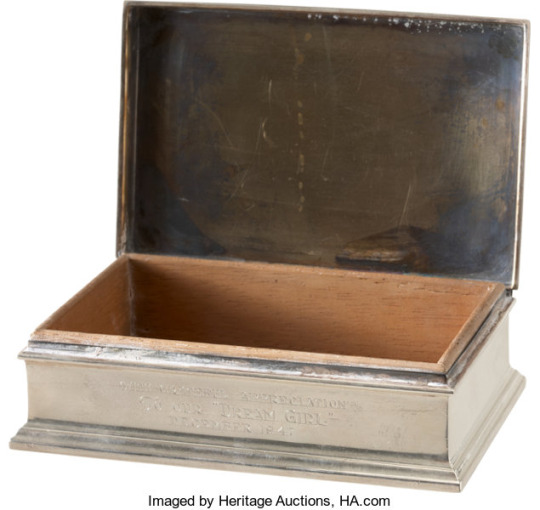
This sterling silver cigarette case was a gift to Lucy from the DREAM GIRL company and is engraved on the front: "With Grateful appreciation TO OUR 'DREAM GIRL' December 1947." The lid has the engraved signatures of the company, 17 in all, including actors Scott McKay, Guy Standing, and Andy Duggan. The item came up for auction after the death of Gary Morton.

While Lucy and the DREAM GIRL company were touring, they knew that a film adaption had been made and was awaiting release. It starred Betty Hutton and MacDonald Carey, but did not open to the public till later in 1948. Lucille Ball and Desi Arnaz took a chance on Hutton in 1959, giving her a CBS sitcom “The Betty Hutton Show” which ended after 30 episodes.
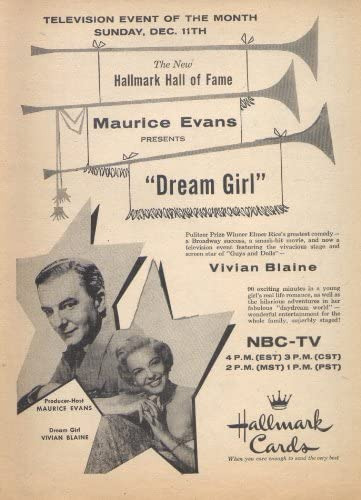
In 1955, while Lucille Ball was busy with “I Love Lucy,” NBC made DREAM GIRL into a TV film starring Vivian Blaine. It featured “Lucy” character actors Hal March and Ida Moore.

Ten years later, it was turned into a Broadway musical named Skyscraper, with the play adapted by Peter Stone (”1776″) and starred Julie Harris in her first musical. It earned five Tony nominations. Charles Nelson Reilly guest-starred on “Here’s Lucy” in 1970. Peter Marshall played Lucy’s brother-in-law Hughie on “The Lucy Show” in 1963. Choreographer Michael Kidd also did the dances for Wildcat starring Lucille Ball in 1960.
#Dream Girl#Lucille Ball#Edgar Rice#McCarter Theatre#Barbara Morrison#Jus Addiss#I Love Lucy#Skyscraper#Julie Harris#Vivian Blaine#Betty Hutton#Hayden Rorke
8 notes
·
View notes